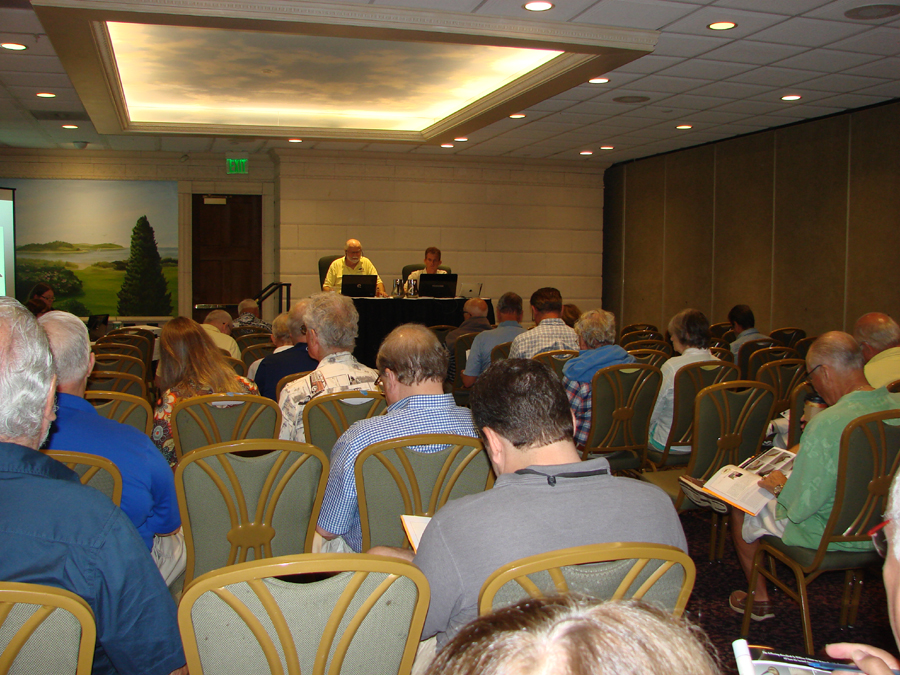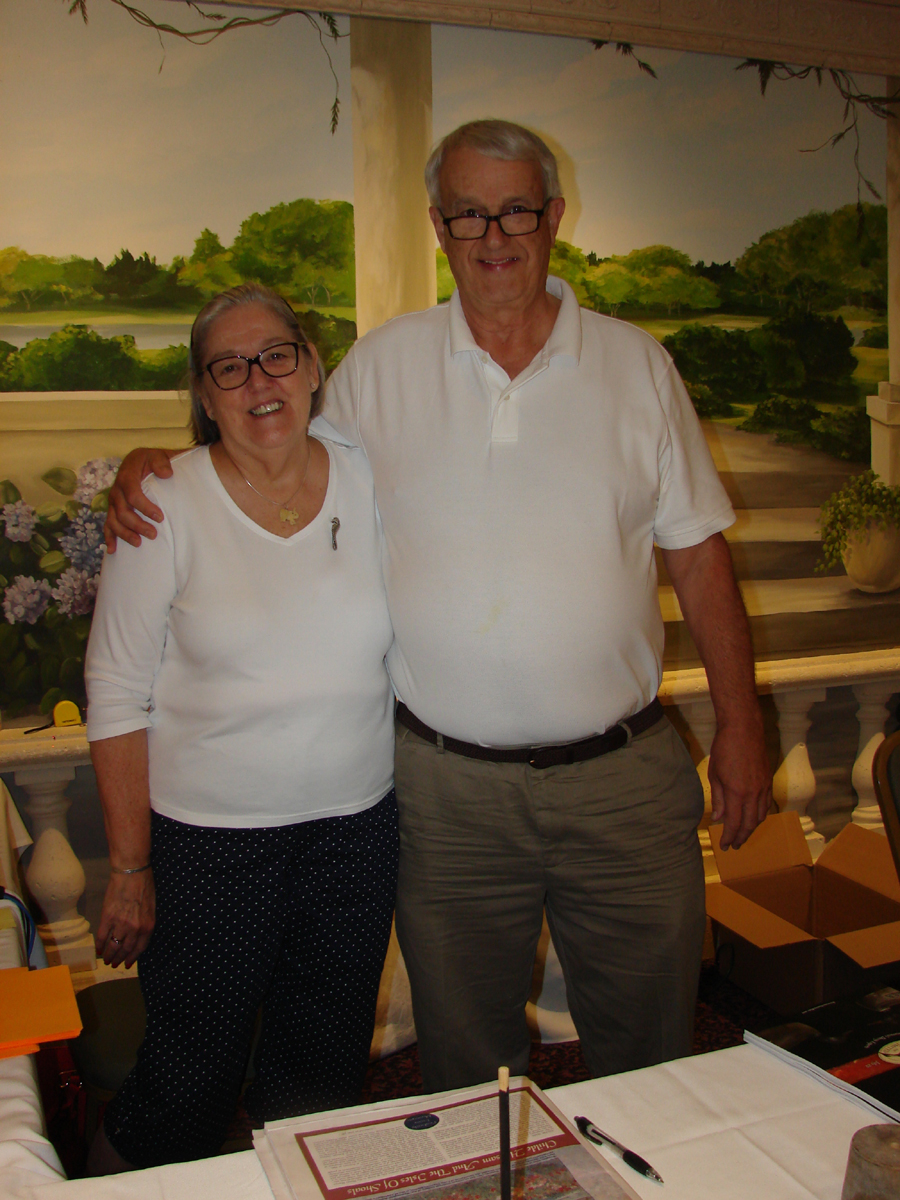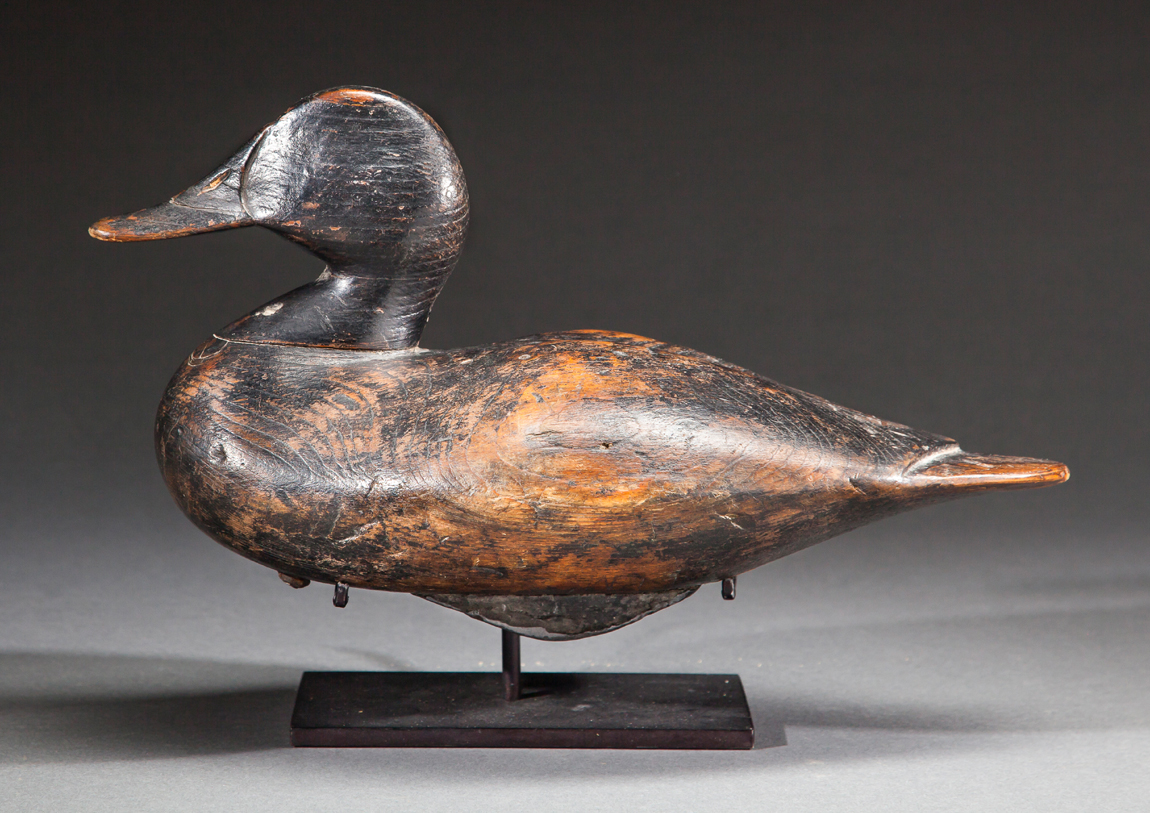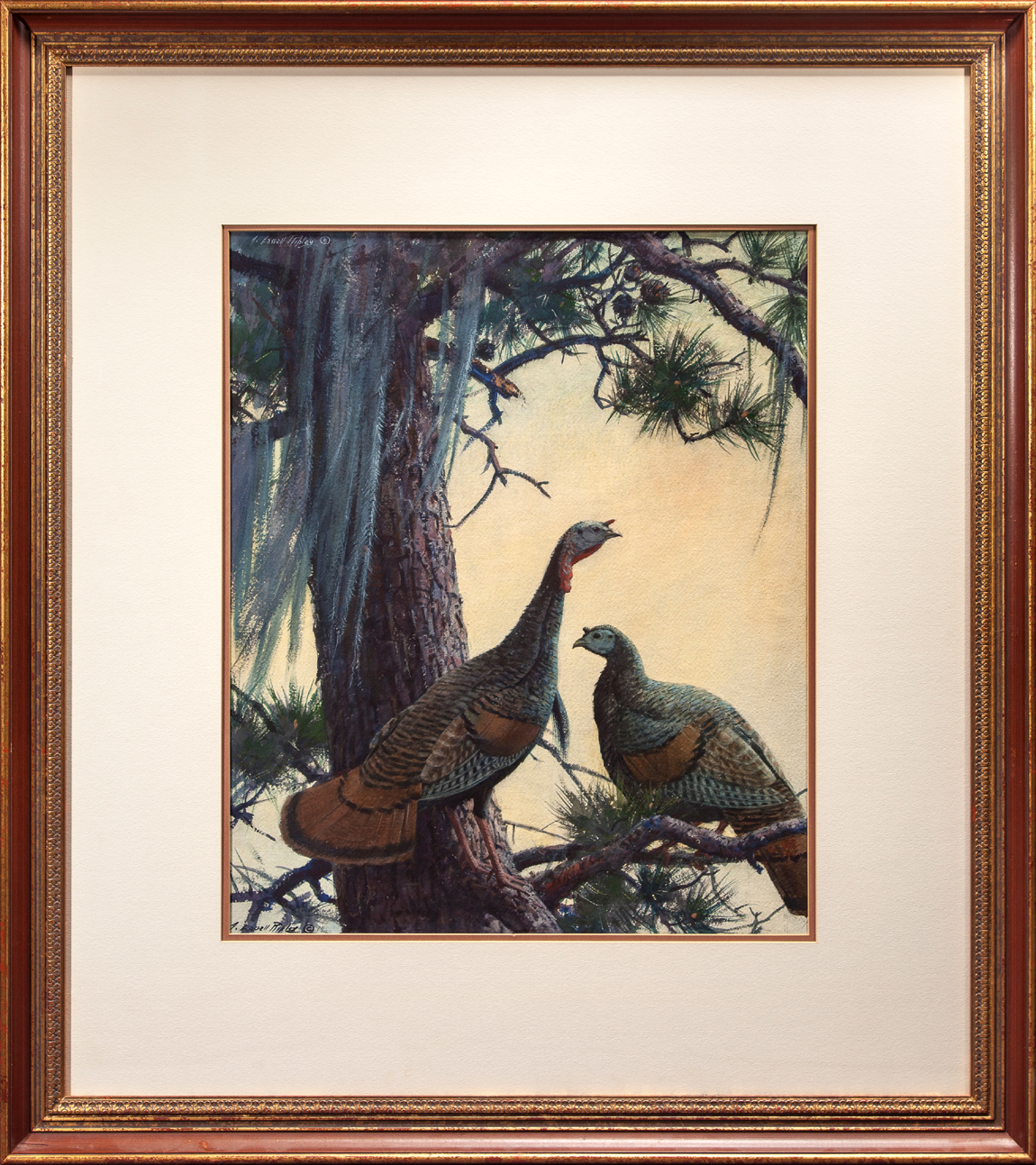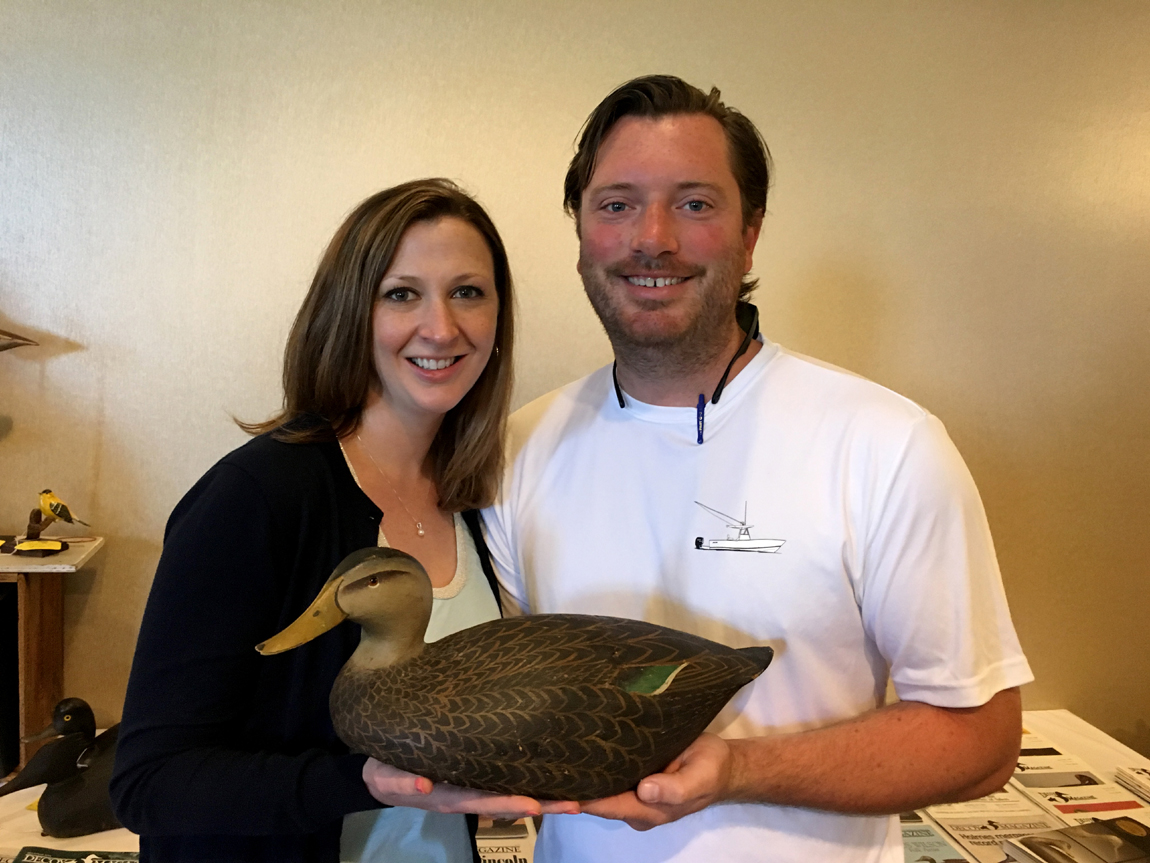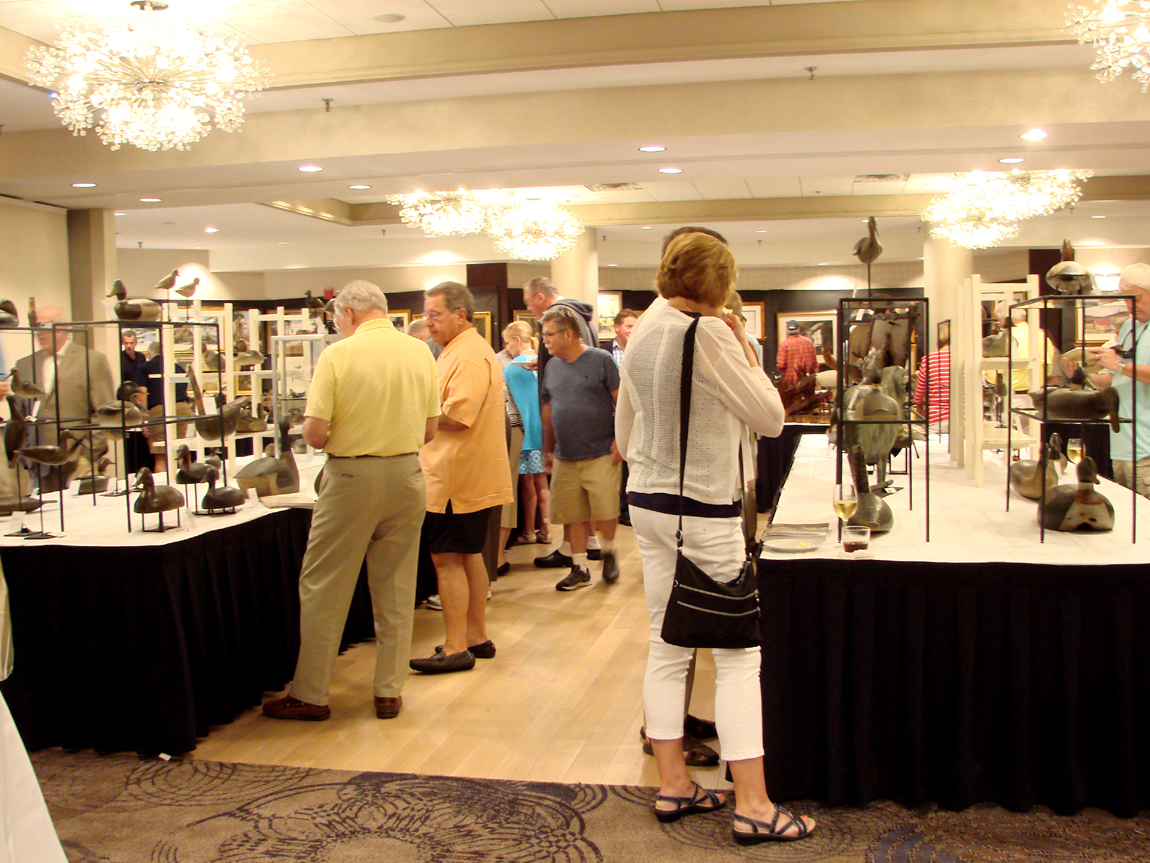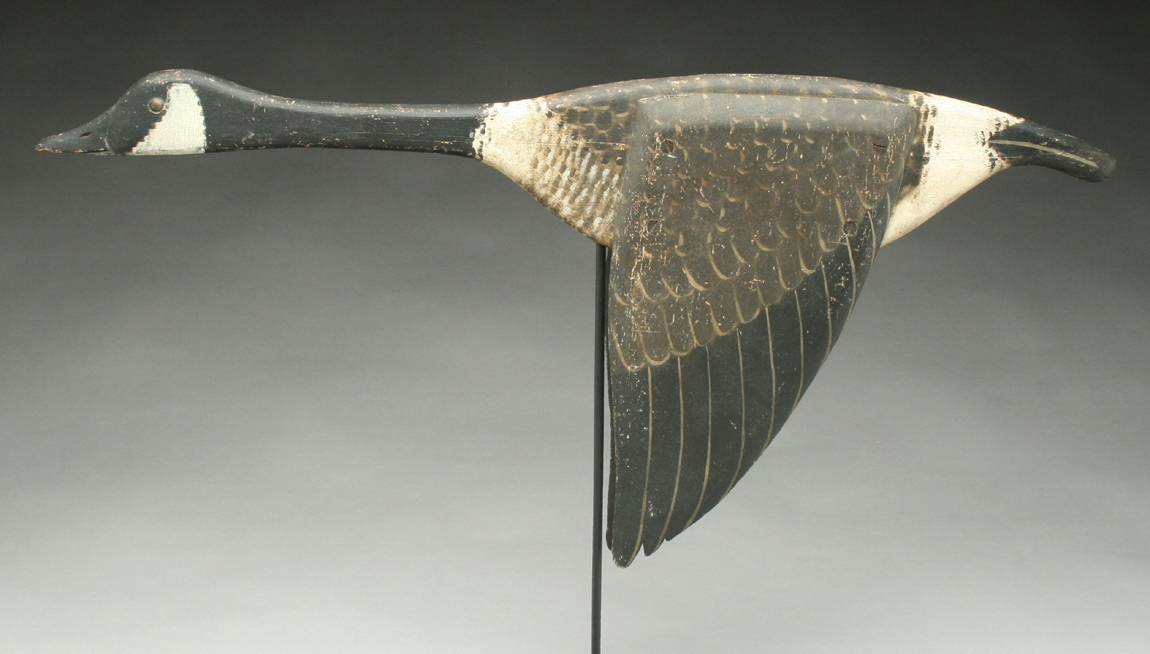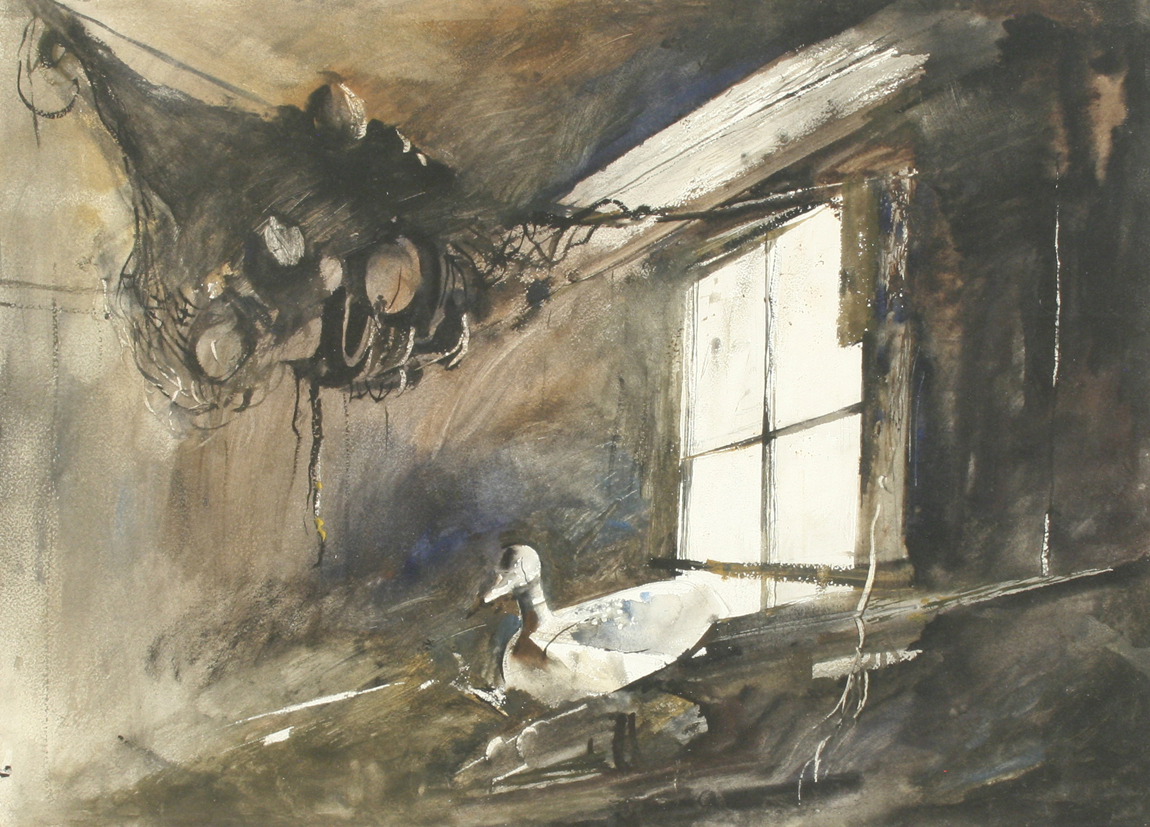
The top selling lot of Decoy Week was this Canada goose decoy carved by Joe Lincoln. Known as a “hisser” because of the position of the head, the decoy sold for $299,000, establishing a new record for the carver. It was in fine condition, had impeccable provenance, had been exhibited at the Peabody Museum and had been illustrated in several decoy publications.
Reviews and On-Site Photos by Rick Russack, Photos Courtesy Auction Houses
Between July 22 and July 27, decoy and sporting art auctions were conducted by Decoys Unlimited, Copley Fine Art Auctions and Guyette and Deeter. Each produced high-quality, informative, full color catalogs, and together the three catalogs had more than 675 pages, listing about 1,660 lots. Each of the sales was within 125 miles of one another and the amount of merchandise drew bidders from all over the country.
Ted Harmon’s Decoys Unlimited sale, which grossed more than $800,000, produced the highest priced lot of the week, a Joe Lincoln “hissing” goose, which sold for $299,000.
Steve O’ Brien Jr’s Copley Fine Arts Auction grossed $1.4 million and was topped by a plover decoy by Lothrop Holmes that attained $144,000. An Andrew Wyeth watercolor topped the sporting art offerings, bringing $63,000. Eleven decoys finished with five-figure prices and 16 artworks also finished in the five figures.
Gary Guyette and Jon Deeter’s North American decoy sale, also with a strong selection of sporting art, produced the highest gross sales of the three auctions, just under $3 million, with about 65 lots finishing in five figures. The top selling decoy here was a golden plover by John Dilley at $103,000. A bronze sculpture of a big horn sheep by Carl Rungius, reaching $100,625, was the top lot of its sporting art selections, which also included watercolors by Andrew Wyeth, Frederic Remington and A.B. Frost.
Prices were strong across various categories of decoys. Shorebirds did well at each sale, as did miniatures and decorative carvings. Works by Elmer Crowell, Joe Lincoln and factory birds by Mason’s did well wherever they were offered. Long Island decoys were strong in each sale, as were decoys from the Chesapeake Bay region, and New England birds, as might be expected, did well. Although our reviews of each sale stress the high value lots, hundreds of lots sold in the three-figure range. Several collectors and dealers said they believed that the decoy market was recovering from the downturn of recent years and that many new collectors are entering the field.
Nor did the sales only include decoys and paintings. There were weathervanes, folk art canes, ammunition boxes, Nantucket baskets, reference books, etchings, Currier & Ives prints and more. Perhaps most importantly, the three sales, bringing together collectors from all over the country, provided a chance for old friends to catch up with one another. And learn from one another.
Ted Harmon’s Joe Lincoln Goose Hits $299,000 To Start Decoy Week

Joe Lincoln, at the age of 76, painting some of his decoys at his outside workbench. Photo courtesy of Cap Vinal, author of a book on Joseph W. Lincoln. Photo by Leslie R. Jones.
HYANNIS, MASS. — Ted Harmon’s July 22 sale got Decoy Week off to a good start. It was the first of three major sporting sales within a six-day period, all within easy driving distance of one another. The premier lot of the sale was a very special Canada goose decoy by Joe Lincoln, which sold for $299,000, setting a new record for Lincoln decoys.
Eight lots brought five-figure prices. Harmon’s sale had more than 75 decoys made by Elmer Crowell, including miniatures, decorative carvings and full-sized hunting decoys and about 20 Mason factory decoys. In addition to the Joe Lincoln goose, another 19 Lincoln decoys crossed the block. All in all, the sale grossed $855,111.

Tern decoys were important to the market gunners supplying the millinery trade. Made by an unidentified Long Island carver, this bird, from the Seaford school, was found in an attic in Bayshore, N.Y. With carved wings and wingtips, and dry original paint with stippled feather detail, it earned $25,875.
The $299,000 Canada goose was from Ted Harmon’s personal collection. He told Antiques and The Arts Weekly that he purchased it about 40 years ago from the late Jack Brayton, of Westport, Mass., who used this decoy at one of his shooting blinds. “I was at his home, and he had geese scattered around on his living room floor. He was a very amiable guy, and he invited me to go hunting with him. I regret that I didn’t take him up on his offer, but at that time, I was more interested in hunting wooden waterfowl than the real thing. I am still totally enamored with the history and the art form. Anyway, I left with the goose.”
The head was in the rare “hissing” position and the catalog described the decoy as perhaps “the finest Lincoln goose known.” The decoy had been pictured in American Vernacular by Ricco and Maresca and in Joseph W. Lincoln… by Cap Vinal. Lincoln (1859–1938) started carving as a boy, making miniatures. He made decoys for several species of ducks and would also make decoys for special orders. There were several other Lincoln decoys in the sale. An early period Canada goose in original paint, circa 1890, with an atypical arched neck, brought $4,025 and a widgeon hen, also in original paint, went for $10,350. A rare, seldom seen “sporting” grade yellowlegs having a baleen bill, realized $6,613. These birds were Lincoln’s most expensive, being made for “sports,” and this one had a two-piece, vertically laminated construction.
The sale included about 75 lots of hunting decoys, miniatures and decorative carvings by Elmer Crowell, (1862–1952), one of the country’s premier decoy makers. A life-sized semi-palmated plover, with exceptional feather detail, in original condition, finished at $17,250, and a ruby throated humming bird in the flying position, mounted on a piece of driftwood, sold for $11,500. It was one of only two known examples and was in fine, original condition. A full-sized goldeneye drake, with an oval mark, and in original paint with only moderate wear, achieved $6,038, and a bluebill hen, with a sharply turned head, in original paint, reached $4,025. When the decoy shows moderate to heavy wear, it is possible to take home Crowell decoys for less than $500. An early goldeneye hen with heavy gunning wear and hit by shot, sold for $432.
Crowell miniatures continue to be popular with collectors. As with other decoys, condition and rarity of the species dictate value. Prices ranged from $920 for an unmarked laughing gull with painted feather detail and in excellent condition to $3,738 for a jacksnipe in fine original condition, with a rectangular mark. Several sold between $1,000 and $2,000.

Decoys and miniatures by Elmer Crowell sold well at each of the three auctions. Harmon had several, led by this life-size semi-palmated plover, in superb original condition. It is one of the rarest of Crowell shore birds and was signed in Crowell’s hand, and it realized $17,250.
Russ Goldberger, who has been selling decoys for nearly 40 years, provided us some basic information about Crowell miniatures. “Crowell was a prolific carver, working over a long time span. His earliest miniatures date from around 1900. It is felt that Crowell’s best work was done in the 1910–25 period. Arthritis made him stop working in the 1940s. His son, Cleon, worked with him casually after World War I and officially after 1928. Different marks were used over the years, and those marks can influence value. From the time his son joined him, a rectangular shaped impression was applied to the base of all their decoys. Prior to 1928, a round ink stamp was used.”
“Crowell originally sold his miniatures in sets of 25 and there were three different sets; songbirds, shorebirds and ducks. The price of each set was $25, and shorebirds were the least popular then but are now the scarcest. If a customer asked to have a particular type bird included in place of one of the standard 25, Crowell would accommodate that request. As a result, there are certain species that are much less common, since they were not part of the basic sets. So, at least three factors enter into determining value: age, rarity and condition. The market is strong for miniatures. They fit well into today’s smaller homes and we’re seeing that women are now collecting them, whereas not that long ago decoy collecting was primarily a man’s hobby. Now husbands and wives often collect jointly,” Goldberger added.
There are several good books on miniatures. Birds in Wood and Paint by Joseph H. Ellis, covers the subject well and includes four chapters on Crowell. The book can be purchased on Goldberger’s website, www.rjgantiques.com, or from Judy Loto’s website, www.booksaboutantiques.com.
Decoys made on Long Island were popular, with a rare, early tern decoy bringing four times its estimate, $25,875. It was one of a group of five decoys from the Harry Scala rig from Bayshore, N.Y., recently found in the attic of the family home. It dated to circa 1870–90, with graceful carving and a thinly carved tail. Tern decoys were an important tool of market gunners, working for the feather trade. From the same group, a small sanderling, or peep, probably made by a member of the Verity family, fetched $4,888. A classic greater yellowlegs by John Henry Verity (1788–1866), with craved wings and wingtips, and old gunning paint, reached $9,200. He fought in the War of 1812, and this example is one the family’s earliest birds.
A group of Cape Cod decoys included several made on Martha’s Vineyard. A wide-bodied merganser hen, attributed to James Look, who died in 1927, brought $6,325. The attribution was based upon Look’s distinctive wing paint. Another merganser made on the Vineyard by Henry Keyes Chadwick (1865–1958) reached $3,450. The head was turned slightly to the right and the decoy appeared never to have been used. A black duck, by another Vineyard carver Warren Pease (1866–1938), made $2,300. It also was apparently never used and had fine feather detail.
Factory-made decoys were well represented, including examples by Mason’s, Stevens, Hays and others. A glass-eyed blue-winged teal drake from the late 1800s, made by the Stevens Decoy factory, Weedsport, N.Y., earned $10,350. Only 14 glass-eyed blue-winged teal drakes are known to exist. A Mason’s premier grade mallard hen, with original paint, minor wear, and a professional repair to the tail, sold for $1,725. A premier grade black duck, in original paint and light gunning wear, achieved $1,265. A Hays factory, superior grade redhead drake, in original paint with moderate wear, went out at $288.
As one might expect at a New England sale, other regional birds did well. A classic merganser by George Huey (1866–1947), from Friendship, Maine, achieved $12,650, and a Canada goose by Seabrook, N.H., carver George Boyd, finished at $4,600. A “rocking head” calling black duck by Gus Wilson (1864–1950), a Maine lighthouse keeper, reached $4,313, and a circa 1920 black duck by Wilson earned $1,955. A hooded merganser drake, made by Frank Dobbins of Jonesport, Maine, went home with a new owner for $230.
Other interesting items in the sale included a colorful fish decoy by W. Flanigan, (1917–1970) which finished at $2,875, a “bird tree” from Pennsylvania with a robin and a nest full of baby robins. It was 26 inches tall, dated as circa the early 1900s, and sold for $1,955. A deeply carved and well-painted, half-sized bald eagle, carved by Carl Malmstrom of Long Cove, Maine, realized $575. Malmstrom was a shipyard worker during World War II.
All prices reported include the buyer’s premium.
For additional information, www.decoysunlimited.net or 508-362-2766.
A Noted Lothrop Holmes Plover Glides To $144,000 At Copley Sale
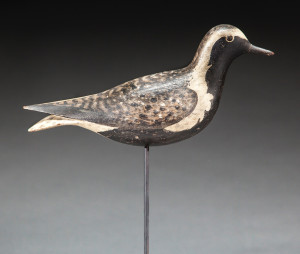
The star of the sale was the McCleery-Holmes plover, which sold for $144,000. It was carved by Lothrop Holmes, circa 1880, and had been part of the collection of Dr James McCleery, which grossed more than $10 million in 2000, by far the record for a decoy collection. It was purchased by dealer Russ Goldberger, bidding for a client.
PLYMOUTH, MASS. — Copley Fine Arts’ July 22 sporting sale, put together by Steve O’Brien Jr and his team, included several high-quality sporting paintings and numerous decoys. Leading the sale was a plover decoy by Kingston, Mass., carver Lothrop Holmes, which achieved $144,000.
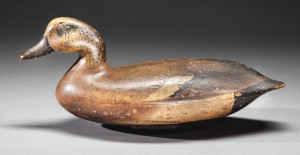
One of the stars of the sale was a widgeon drake by John Blair Sr of Philadelphia. Decoys of this form are considered “classic Blairs” and represent some of the finest carvings of the Philadelphia school of carvers. It realized $90,000.
Leading the sporting art selections was a watercolor by Andrew Wyeth going out at $63,000. Eleven decoys finished in the five figures, and 16 artworks also finished in five figures. The top ten decoy lots, in total, sold for $468,000, and the top ten fine arts pieces, in total, brought $285,600. The well-attended sale grossed $1,417,752. There had been numerous left bids, several phone lines were in use and internet bidding was available. Lynn, Mass., auctioneer Peter Coccoluto kept the sale moving briskly. A decoy show and sales area was open the day of the preview and during the auction.
Prior to the sale, Antiques and The Arts Weekly had a conversation with Steve O’Brien Sr about decoy collecting. The elder O’Brien was instrumental in the formation and development of his son’s company. O’Brien Sr said he collects folk art and baskets, along with decoys. “We grew up in a family that hunted and fished, going back to my grandfather who lived on Long Island. When I started collecting decoys, we weren’t as concerned about who made it as today’s collectors are.”
“Most important was the form and next in importance was the condition of the surface. Maker was the distant third component of desirability. Accuracy of the painting and construction, as compared to a real bird was crucial. Most decoy collectors are hunters, and they know what a particular bird should look like. The decoys that most closely resemble the real bird will, to me, always be the most desirable.”
Jumping into the conversation, O’Brien Jr said that he fully agrees with his dad. “Being a hunter and a fisherman really helped me learn and understand form. It’s the first thing we look at when evaluating a decoy. I owe a lot to dad.” He also agreed with his father’s statement about most decoy collectors being hunters or fishermen. “Just a little while ago, I was taking some bids from a client who is in Montana trout-fishing.” Carrying the thought about condition a little further, he commented on the importance of having Colin McNair, decoy specialist, as part of his company. “Colin’s been with me about nine years, and his background as a carver enables him to spot repairs and restorations that other people might miss.”
The McNair family includes three skilled carvers creating bird and large fish decoys. Mark McNair, father of Colin and Ian, is one of the premier carvers today, and several of his carvings started the auction which began with works by contemporary carvers. A pair of feeding yellowlegs by Mark McNair (b 1950) brought $5,400, a gadwall drake reached $3,000, and a 48-inch sperm whale fetched $4,500. Mark has been carving for about 45 years and both sons have been carving for about 25 years.

A circa 1920 preening mallard by Illinois River carver Bert Graves had been painted by Catherine Ellison. According to the catalog, “many in the decoy collecting field, consider this to be the finest Graves decoy ever to be offered.” It had been illustrated in three decoy books and came from the well-regarded collection of Gene Konopasek. It went to a phone bidder for $75,000.
A large bluefin tuna by Colin McNair sold for $3,600, a record for the carver. Both Colin and Ian sold their first carvings while still in grade school. Colin said, “Learning to work with wood came along with everything else like learning to read, write and ride a bike.” Both were homeschooled, and thus had plenty of time for woodworking and by the time they were in high school they were selling at decoy shows and that continued through college.
In addition to the McNair carvings, birds by other contemporary carvers also did well. A pair of pintails by Robert “Bob” White (b 1939) reached $2,280, and his oversized mallard drake earned $1,920. Several carvings by another of today’s premier carvers, William Gibian (b 1946) came next and a calling Hudsonian godwit finished at $1,080.
The top lot of the auction was a decoy known as the McCleery-Holmes plover, which sold for $144,000 — so far the top price for a shorebird this year. Carved by Lothrop Holmes, Kingston, Mass., circa 1880, the decoy had been owned by the legendary decoy collector Dr James McCleery. When the McCleery collection was sold in 2000, it grossed more than $10 million, still a record for a decoy auction. The decoy had been published in five separate decoy books, including Call To The Sky-The Decoy Collection of James M. McCleery, M.D., 1992. In addition to the impeccable provenance, the catalog entry stated, “This bird features everything that seasoned collectors look for in a Massachusetts shorebird, including a renowned maker, impeccable provenance, rarity, exceptional form and paint, and stellar condition.” It was purchased by Russ Goldberger, bidding for a client.
Commenting later, Goldberger said, “The decoy market is alive and well. There appears to be particular strength at the higher end where committed collectors are willing to pay for the best examples. Internet bidding appears to have displaced eBay as a source of less expensive decoys. After all, some auction houses provide guaranteed descriptions which give some confidence when you cannot handle the birds. Encouragingly, we are seeing some new collectors who are often driving the market. Decoys by Elmer Crowell continue to remain the gold standard; the best Mason decoys seem to always do well.”
Echoing his sentiments was Don Kirson, a collector from Maryland. Kirson’s approach to collecting is different than most others in that he does not collect the work of a single region or carver. He tries to collect truly outstanding decoys, regardless of who made them or where they were made. “I think the market is starting to get back to 2004 levels. There seems to be an influx of new, younger decoy collectors. Harmon sold the Lincoln “hisser” for $299,000. I know that the person who bought the Laing black duck for $97,750 in this auction is a new collector.” Kirson keeps a folder of photographs on his phone of birds that he would eventually like to own. He bought one of those birds, made by the Stevens Brothers. Harvey Stevens, and his brother worked in Weedsport, N.Y. Kirson said, “I’ve been watching that bird for over ten years since it sold for $42,500 in 2006. I was the underbidder then but I was finally able to get it this time.”
Selling for $90,000 was a widgeon drake by John Blair Sr of Philadelphia, circa 1880. It was a “classic” Blair, having the construction details known to have been used by Blair. Blair was a wheelwright and carriage maker who, after retiring, spent much of his time hunting and fishing, making his own decoys. This example was in fine original paint, with even gunning wear and had been owned by Don Kirson.
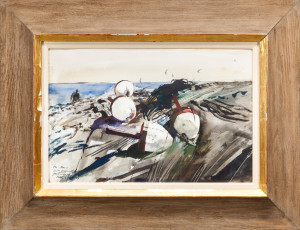
Andrew Wyeth’s watercolor, “Terns on Little Green Island, Maine, 1940,” was inscribed by the artist: “For Bess with warmest greetings, Betsy and Andy.” It was included in two publications on Wyeth and exhibited in New York in 1995. Its final price was $ 63,000.
Finishing slightly behind the widgeon was a preening mallard drake, circa 1920, by Bert Graves from the Konopasek collection. It had been painted by Catherine Elliston, who worked for the Graves Decoy Company. Graves’ decoys were expensive in their time, selling for $75–$100 a dozen to wealthy sportsmen and sporting goods stores. Considered to be one of the finest Graves decoys because of its original paint, form and fine condition, it achieved $75,000, believed to be an auction record for a single Graves decoy.
A very fine North Carolina widgeon decoy by Lee Dudley, circa 1890, earned $34,800. Dudley decoys were a favorite of Joel Barber and the first three plates of his 1954 book, Wild Fowl Decoys picture Dudley decoys. A Dudley decoy at the Shelburne Museum, in 1981, was voted the best of the museum’s collection. Gus Wilson (1864–1950) was a boat builder, and lighthouse keeper along the Maine coast in addition to being an outstanding carver of decoys, weathervanes, decorative birds and big cats. A pair of tigers he carved is in the collection of the Brooklyn Museum. A preening eider drake of his was included in this sale and it realized $27,600.
A group of about 15 decoys deaccessioned from Long Island’s Southold Historical Society were sold. The historical society focuses on the North Fork of Long Island and decided that these decoys, from the South Fork, did not meet its geographic criteria. The decoys had been acquired from a single owner in 1965. Specific makers were not known, but they were of fine form and surface and all found new homes. A particularly nice gull decoy led the group, finishing at $21,600, well over its estimate. Gull decoys are rare as they were only used on the Atlantic coast as confidence decoys. Only one related example is known and it is pictured on the dust jacket of George Starr’s Decoys of the Atlantic Flyway. Also from the historical society, and going well over the estimate was a black duck drake, with raised, serrated, wing carvings and original paint. It earned $11,400. Several of the birds from this consignment sold to the same bidder, so a part of the collection will remain intact.
Sporting art was a major component of the sale, and several paintings were among the top-grossing lots of the day. An Andrew Wyeth (1917–2009) watercolor, “Terns on Little Green Island, 1940” went out at $63,000. It depicted a lobsterman, four pot buoys in the foreground of a small Maine coastal island and a number of terns in the sky. The painting had been given as a gift by the artist and was inscribed “ For Bess with warmest greetings Betsy & Andy.” Bess lived in Connecticut and was a summer resident of Rockland, Maine, and a friend of the artist and his wife. Also doing well was a watercolor by A.B. Frost (1859–1928) titled “Grouse Shooting in the Rhododendrons.” The painting was the original watercolor reproduced by the Derrydale Press in a set of four Frost etchings, published in 1933–34. Frost was an avid outdoorsman, as well as one the outstanding illustrators of his time. The watercolor achieved $57,000.
Also crossing the block were several limited edition etchings by Frank Benson (1862–1951), who summered in New Hampshire, was an active fisherman and produced hundreds of works with hunting and fishing themes. Prices ranged from $3,600 for “Old Tom,” a portrait of a hunter with his shotgun and a duck he had shot and a beach in the background, to $300 for a scene showing a pair of mallards taking off or landing in a marsh. Edition size of both was 150.
A watercolor by Aiden Lassell Ripley (1896-–1969), depicting two wild turkeys in a pine tree, doubled its estimate, reaching $30,000. Probably not surprisingly, there were several paintings of hunting dogs, some at work with hunters, and some portraits of, presumably, favorite dogs. One of the highest prices was achieved by a 1901 oil painting of two setters at work by Gustav Muss-Arnolt (1858–1927). The painting had been commissioned by Samuel Henry Vandergrif, a wealthy Pennsylvania oil man and breeder of English setters. The painting achieved $19,200, more than double the estimate.
There were more than 467 lots in the sale and 90 percent sold. O’Brien said, “Several of the decoys in the sale were outstanding examples of a carver’s work, like the Holmes plover and the Blair widgeon. Some have never been sold at auction before. We were within estimates for most of the lots. The sporting art offerings were strong, and as of August 1, Terry Vose, formerly co-president of Vose Galleries, will be joining us. He’s extremely knowledgeable in Hudson River paintings, as well as American Impressionism and post Impressionism. His expertise and contacts will add another dimension to our company. All in all, we’re very pleased with the results of the sale. We had a good turnout and some great stuff found new homes.”
All prices reported include the buyer’s premium.
For additional information, www.copleyart.com or 617-536-0030.
Guyette & Deeter Auction Nears $3 Million For Decoys, Sporting Art

The top decoy lot of the sale was this golden plover in transitional plumage by John Dilley, Quogue, Long Island, N.Y. The wings were cut in relief, and the detail of the feather painting was exceptional. The decoy sold for $ 103,500.
PORTSMOUTH, N.H. — On July 26–27, Gary Guyette and Jon Deeter sold 574 lots of sporting art and fine decoys. More than 65 lots sold over $10,000, and two sold for more than $100,000. The top decoy lot was a golden plover by John Dilley that attained $103,500, and a greater yellowlegs shorebird by William Bowman that reached $89,125.
Art did well, with a bronze sculpture of a big horn sheep by Carl Rungius reaching $100,625, an Andrew Wyeth watercolor bringing $94,875 and a rare sporting scene by Frederic Remington finishing at $74,750. Guyette & Deeter sales appear to be a popular social event of the summer decoy season, with many dealers and collectors meeting up with old friends. More than 200 people were at the catered preview the evening before the sale, and many wives accompanied their husbands. Buyers’ comfort levels are undoubtedly increased by the guaranteed condition reports and a buyer’s premium that has remained at 15 percent. Jim Julia conducted the auctions, moving at a good pace and keeping the crowd entertained with his “Downeast” humor.

The limited edition bronze sculpture of a big horn sheep by Carl Rungius was the highest priced of the selection of fine art. Marked “C/R1915,” it was 16½ inches tall and sold for $100,625.
The auction included more than just decoys and sporting art. There were some Nantucket baskets, folk art walking sticks, two early weathervanes, Charles Hart penguins, duck calls, firearms advertising and ammunition boxes. The highest priced items were decoys and paintings, as expected. Dilley’s golden plover that led this sale was an exceptional decoy. He worked on Long Island and is considered one of the premier carvers. One of his decoys sold for $142,500 in 2007. The plover at Guyette & Deeter’s sale was in rare, transitional plumage, with finely carved wings and very intricate feather painting. But for very slight wear to the tip of the tail, the paint was in original condition. William Bowman is another of the premier carvers, also from Long Island, and his greater yellowlegs ($89,125) had shoe button eyes and a well-sculpted form, with its head in a slightly resting pose, along with relief wing carving and extended wing tips. The paint was near mint, and it had a fine patina with good detail.
Hunting decoys, miniatures and decorative carvings by New England makers did quite well. A full-sized preening black duck by Elmer Crowell, with his rectangular mark, and an elongated neck over its back, brought $43,125. Shorebirds by Crowell, regardless of the size, continue to be sought-after. His hunting decoys from the late Nineteenth and early Twentieth Centuries did well. A greater yellowlegs with tack eyes and good feather paint brought $13,800, while a running greater yellowlegs went for just a little less, reaching $13,225.
Crowell’s decorative carvings included a full-size flying Canada goose weathervane with detailed feather painting that sold for $25,300. According to Crowell’s order book, these weathervanes were popular from 1927 to 1933 and retailed for $35 each. A decorative, full-sized golden plover on a carved clam shell base earned $34,500. It had fine paint detail and slightly separated wing-tips. Prices for Crowell’s miniatures ranged up to $4,600 for an early, unstamped spotted sandpiper. Not all were expensive; a miniature redhead drake, with minor wear and paint flaking, was bought for $690. A merganser drake with a slightly turned and raised head, by New Hampshire carver George Boyd, realized $19,550 A canvas-over-wood frame Canada goose by Boyd reached $8,050, while a black bellied plover finished at $2,300, held back by minor discoloration and some professional touch-up to the face and a replaced bill. A running willet by Gus Wilson ended up at $2,875, while a flying black duck by the same carver ended up at $1,150.
A wide selection of Mason Decoy Factory decoys, including shorebirds, ducks and geese, drew strong phone and internet bidding, as well as from those in the room. Mason produced decoys in various grades, with the premier grade originally being the most expensive, followed by the challenger grade, followed by the standard grade decoys, and those varied depending on the type of eyes used. A premier grade Canada goose, with bold original paint and minor professional repairs, brought $15,525, and a tack-eye robin snipe in spring plumage, in near mint condition, earned $5,175 from a bidder in the room. A premier grade redhead hen, with near mint original paint, also sold for $5,175. Catalog descriptions for several of the Masons in the sale refer to Mason Decoys, by Russ Goldberger and Alan Haid, the basic book on the subject. Goldberger’s website, www.rjgantiques.com has more information about the various grades of Mason decoys, including a list of the original factory prices.

One of the top decoy lots of the sale was a hollow, carved preening black duck made by Albert Laing, of Stratford, Conn., in the mid- to late Nineteenth Century. The lifted head pose is unusual. In original paint, with minor wear, it achieved $ 97,750.
Valuing decoys is almost more art than science. Jon Deeter discussed that subject with Antiques and The Arts Weekly and used decoys by the Ward Brothers to illustrate the subject. The sale included about two dozen examples by these prolific carvers from Crisfield, Md., where both were barbers. They were actively producing decoys for more than 50 years, and in addition to making decoys for hunters, they also made miniatures and life-sized decorative decoys of several species.
Prices for Ward Brothers decoys at this sale ranged from $103,500 to $400. So why the wide price range? Deeter explained, “The pair of mallards that sold for over $100,000 were known as 1936 models. These were the high point of their work, and they used that style for a number of years. This pair represented their best carving and painting. They were in near mint original paint, and they came from the collection of Richard Larrimore and prior to that had been in his father’s collection for many years. They’re illustrated in the book on the Ward Brothers.”
“That selling price wasn’t a surprise. An early “humpback” style pintail drake sold for $46,000. These are thought to have been made about 1925 and represent their scarce early work. A “fat jaw” bluebill drake sold for $11,500. That’s another distinctive type, thought to have been made around 1918 when one of the brothers was in the army. At the other extreme, the bird that sold for $400 appeals to a different buyer. It was a decorative, one-third-size goldeneye drake. They switched to making decoratives and miniatures in the 1950s. So for Ward Brothers decoys we see that earlier examples, all else being equal, may be more desirable. Decoys that were made to be hunted over usually have more value, and then we’d have to consider overall condition, surface and type of bird, since they made more of some than of others. ‘How much is it worth?’ can be a tricky subject,” Deeter said.
Fine sporting artwork contributed significantly to the overall success of the sale. A limited edition bronze sculpture of a big horn sheep by Carl Rungius (1869–1959), approximately 16½ inches tall, marked CR/1915, led the category, finishing at $100,625, the second item in the sale to finish over $100,000. Painted in 1949, “Loon Toller” a watercolor by Andrew Wyeth (1917–2009) fetched $94,875. Also known by an alternative title, “Interior of a Fisherman’s Shack,” it depicted the interior of Henry Teel’s shed on Teel’s Island off the coast of Maine, with spare hunting and fishing gear, including a loon decoy. The painting had been exhibited at the Farnsworth Art Museum in 2000, and came from the collection of Paul Tudor Jones II.
Although Frederic Remington (1861–1909) is best known for scenes of the West and cowboy life, he also produced fine sporting art. “On the Shore of the Tank – Morning,” a watercolor of his, sold for $74,750, well over estimate. Also from the Jones collection, it depicted a hunter with shotgun and dog, looking out over the marshes. Two watercolors of duck hunting scenes by A.B. Frost, (1851–1928) from the Jones collection went to phone bidders.

This outstanding greater yellowlegs by William Bowman had near mint, original paint, shoe button eyes, with its head in a slightly resting pose. Closely related examples had been illustrated in two books on decoys and this one achieved $89,125.
Frost was a prolific illustrator, working for Harper’s Weekly, Scribner’s and Life magazines and he also illustrated more than 100 books. Frost was a hunter and fisherman from an early age. In 1895, Scribner’s published a portfolio of 12 lithographs, two of which were duck hunting scenes. “Ducks from a Battery” was one of these and the original watercolor for that lithograph, in excellent condition, sold for $80,500. In soft colors, it depicted a hunter with a shotgun to his shoulder standing in a sink box surrounded by dozens of decoys with a flock of ducks approaching. The second Frost watercolor, “Duck Shooting,” depicted a hunter in a boat, aiming his shotgun at incoming ducks. It fetched $37,375. This segment of the sale also included works by Rungius, Ogden Pleissner and H. Granville Smith. All sold in the low to mid five-figure range.
As mentioned above, the sale included folk art and related material. Carved penguins by Charles Hart, (1862–1960) included two emperor penguins, one Adelie penguin and a king penguin. The largest, a 10-inch-tall emperor, went for $7,188, the 6½-inch Adelie took $6,612, and the 43/4 -inch king penguin brought $3,450. Even Jim Julia noted that Hart’s penguins seemed much more desirable than a flying mallard drake by the carver, which reached only $345. That one had some minor wear and part of one foot was gone.
Nine Nantucket baskets included a 17½-inch work basket, which earned $2,300, and a swing-handled example, signed by Vera Manion, at $1,380. An unusual duck call, in the form of a drake’s head with a shotgun shell in its mouth achieved $12,650. It was made by Kinney and Harlow Co. of Newark, Ohio, and was covered in leather. The two weathervanes in the sale included a full-bodied ram, 29 inches long, with filled shot holes, which fetched $9,200 and a 32-inch setter dog, attributed to the Washburne Company, which went out for $8,625.
After the sale, Jon Deeter said the sale, which grossed about $3 million, was a success that surpassed last year’s sale by a good percentage. “I think there are two reasons why we’re doing well. We’re the only decoy auction company that guarantees our descriptions, including condition, which is printed in the catalog for each lot. And we’ve kept our buyer’s premium at 15 percent, which is less than some of the others. Buyers know that and we think that encourages them to spend a little more on the object.
We’re also really working at encouraging and educating new collectors. We run weekly online decoy auctions and we guarantee those descriptions just as we do for the catalog sales. The online sales are a good entry point for new collectors, and as they become comfortable with what they’re getting, they often progress to participating in the catalog sales. We’ve also expanded our art sales with the addition of Bob Koenke to our staff. He’s our expert on sporting and wildlife art. He has solid background in that world.”
All prices reported included the buyer’s premium.
For additional information, www.guyetteanddeeter.com, 410-745-0485 or 440-543-1416.


















